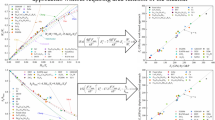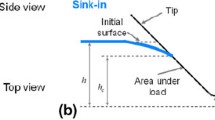Abstract
An electrical technique was recently developed to measure the in situ contact area continuously during instrumented indentation by simultaneously monitoring electrical contact response between a conductive indenter tip and a conductive sample. This technique has the potential to overcome limitations of the Oliver-Pharr method caused by the lack of a direct contact area measurement. However, the electrical contact current-voltage (I-V) curves measured from the technique were nonlinear, posing a significant challenge to inferring accurate in situ contact areas. To overcome this challenge and extend the electrical technique to more applications, various I-V curve analysis methods were investigated for their abilities to infer in situ contact area and hardness. Annealed Cu was indented using both linear and exponential loading tests. When analyzing the resulting data, the feasibility of each method was evaluated and the optimal methods to calculate the in situ contact area and hardness were determined. It was found that a simple summation of the absolute values of area under I-V curves or the area under I-V curves at positive voltages yielded the most robust area measure, whereas error in the inferred contact area was systematic and primarily from velocity dependence of the I-V response.
Similar content being viewed by others
References
B. Bhushan and X. Li: Nanomechanical characterisation of solid surfaces and thin films. Int. Mater. Rev. 48, 125 (2003).
S.J. Bull: Nanoindentation of coatings. J. Phys. D: Appl. Phys. 38, R393 (2005).
A. Gouldstone, N. Chollacoop, M. Dao, J. Li, A.M. Minor, and Y.L. Shen: Indentation across size scales and disciplines: Recent developments in experimentation and modeling. Acta Mater. 55, 4015 (2007).
G.M. Pharr and W.C. Oliver: Measurement of thin film mechanical properties using nanoindentation. MRS Bull. 17, 28 (1992).
W.C. Oliver and G.M. Pharr: An improved technique for determining hardness and elastic modulus using load and displacement sensing indentation experiments. J. Mater. Res. 7, 1564 (1992).
W.C. Oliver and G.M. Pharr: Measurement of hardness and elastic modulus by instrumented indentation: Advances in understanding and refinements to methodology. J. Mater. Res. 19, 3 (2004).
A. Bolshakov and G.M. Pharr: Influences of pileup on the measurement of mechanical properties by load and depth-sensing indentation techniques. J. Mater. Res. 13, 1049 (1998).
Y.T. Cheng and C.M. Cheng: Effects of ‘sinking in’ and ‘piling up’ on estimating the contact area under load in indentation. Philos. Mag. Lett. 78, 115 (1998).
T.Y. Tsui and G.M. Pharr: Substrate effects on nanoindentation mechanical property measurement of soft films on hard substrates. J. Mater. Res. 14, 292 (1999).
R. Saha and W.D. Nix: Effects of the substrate on the determination of thin film mechanical properties by nanoindentation. Acta Mater. 50, 23 (2002).
S.M. Han, R. Saha, and W.D. Nix: Determining hardness of thin films in elastically mismatched film-on-substrate systems using nanoindentation. Acta Mater. 54, 1571 (2006).
L. Fang, C.L. Muhlstein, J. Collins, A. Romasco, and L.H. Friedman: Continuous electrical in situ contact area measurement during instrumented indentation. J. Mater. Res. 23, 2480 (2008).
D.A. Neamen: Semiconductor Physics and Devices—Basic Principles (McGraw-Hill Publishing Company, 2003).
E.H. Rhoderick and R.H. Williams: Metal-Semiconductor Contacts (Clarendon Press, 1988).
R. Holm and E. Holm: Electrical Contacts: Theory and Application (Springer-Verlag, New-York, 1967).
Y.V. Sharvin: A possible method for studying Fermi surfaces. Soviet Physics JETR 21, 655 (1965).
G. Wexler: The size effect and the non-local Boltzmann transport equation in orifice and disk geometry. Proc. Phys. Soc. 89, 927 (1966).
I.N. Sneddon: The relation between load and penetration in the axisymmetric boussinesq problem for a punch of arbitrary profile. Int. J. Eng. Sci. 3, 47 (1965).
X. Chen and J. Vlassak: Numerical study on the measurement of thin film mechanical properties by means of nanoindentation. J. Mater. Res. 16, 2974 (2001).
V.R. Howes, H.J. Goldsmid, and C.A. Baird: Hardness measurement at constant depth using an indenter partially coated with a conducting film. J. Phys. E: Sci. Instrum. 20, 1507 (1987).
L. Wieczorek, V.R. Howes, and H.J. Goldsmid: Electrical contact resistance and its relationship to hardness. J. Mater. Sci. 21, 1423 (1986).
H.J. Goldsmid, V.R. Howes, and C.A. Baird: Measurement of hardness using a semiconductor diamond indentor. J. Mater. Sci. Lett. 6, 1043 (1987).
S. Ruffell, J.E. Bradby, J.S. Williams, and O.L. Warren: An in situ electrical measurement technique via a conducting diamond tip for nanoindentation in silicon. J. Mater. Res. 22, 578 (2007).
Y.Y. Lim and M.M. Chaudhri: The effect of the indenter load on the nanohardness of ductile materials: An experimental study on polycrystalline work-hardened and annealed oxygen-free copper. Philos. Mag. A 79, 2979 (1999).
W.H. Press, S.A. Teukolsky, W.T. Vetterling, and B.P. Flannery: Numerical Recipes in Fortran: The Art of Scientific Computing (Cambridge University Press, 1992).
A.C. Fischer-Cripps: Nanoindentation (Springer-Verlag, New York, 2004).
M.A. Lampert and P. Mark: Current Injections in Solids (Academic Press, New York and London, 1970).
J.R. Taylor: An Introduction to Error Analysis: The Study of Uncertainties in Physical Measurements (University Science Books, 1997).
M. Atkinson: Further analysis of the size effect in indentation hardness tests of some metals. J. Mater. Res. 10, 2908 (1995).
E. Crinon and J.T. Evans: The effect of surface roughness, oxide film thickness and interfacial sliding on the electrical contact resistance of aluminum. Mater. Sci. Eng., A 242, 121 (1998).
E. Barthel: Adhesive elastic contacts: JKR and more. J. Phys. D: Appl. Phys. 41, 1 (2008).
R.S. Timsit: Electrical conduction through small contact spots. IEEE Trans. Compon. Packag. Technol. 29, 727 (2006).
A. Mikrajuddin, F.G. Shi, H.K. Kim, and K. Okuyama: Size-dependent electrical constriction resistance for contacts of arbitrary size: From Sharvin to Holm limits. Mater. Sci. Semicond. Process. 2, 321 (1999).
M.F. Doerner and W.D. Nix: A method for interpreting the data from depth-sensing indentation instruments. J. Mater. Res. 1, 601 (1986).
Author information
Authors and Affiliations
Corresponding author
Rights and permissions
About this article
Cite this article
Fang, L., Muhlstein, C.L., Romasco, A.L. et al. Augmented instrumented indentation using nonlinear electrical contact current-voltage curves. Journal of Materials Research 24, 1820–1832 (2009). https://doi.org/10.1557/jmr.2009.0213
Received:
Accepted:
Published:
Issue Date:
DOI: https://doi.org/10.1557/jmr.2009.0213




